Great evergreen groundcover plants
Great evergreen groundcover plants for your garden. Ground cover plants serve a variety of purposes and can make the garden look great all year round. They suppress weeds by limiting the amount of light that reaches the soil and thus, reduces the number of weed seeds that germinate. Groundcover lessens the likelihood of erosion of the soil by wind or rain, and additionally, the plants’ roots will add to and support the essential mix of life within the soil. And groundcover plants provide shelter for wildlife.
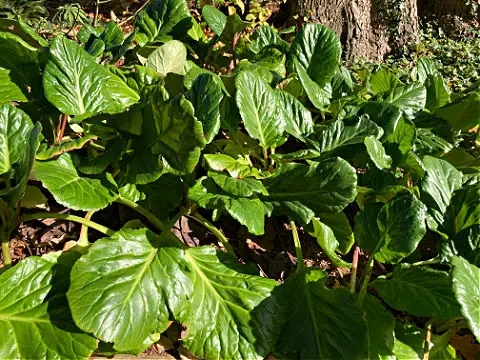
There is a wide selection of plants that provide cover for the soil during late spring, summer and autumn and I love the impact that those herbaceous plants provide in our borders. But for the winter and early spring months, the choices are less obvious. Here are some exciting evergreen and semi-evergreen groundcover plants, that provide texture, colourful flowers or berries, or have interesting leaves.
Glandora prostrata ‘Heavenly Blue’ (Lithodora)
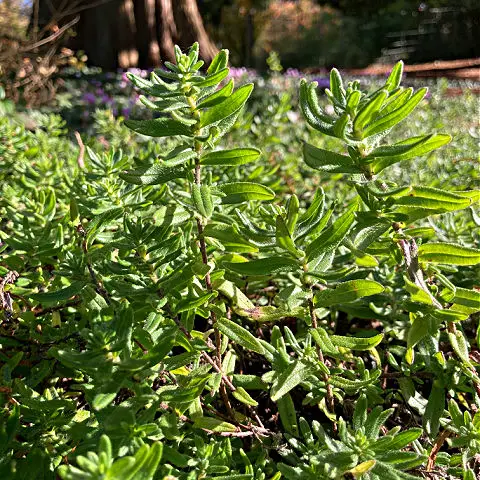
Here’s a gem for well-draining loam or sandy soil. However, it will fail to thrive in heavy soils and water-logged situations. Glandora ‘Heavenly Blue’ prefers full sun, although I’ve seen it growing under a tree on a south-facing spot. Also known as Lithodora, this plant forms a mat across the ground, reaching up to 50cms spread and only 15cm high.
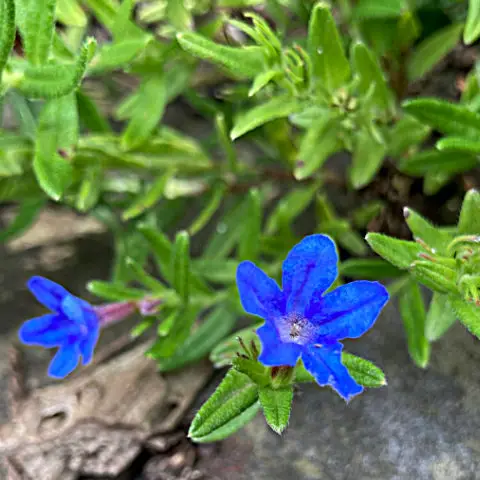
It has evergreen, dark green leaves and intense blue flowers during spring and summer. If your soil is heavy and water-retentive, try growing in a raised bed.
Rhododendron ‘Bloombux’
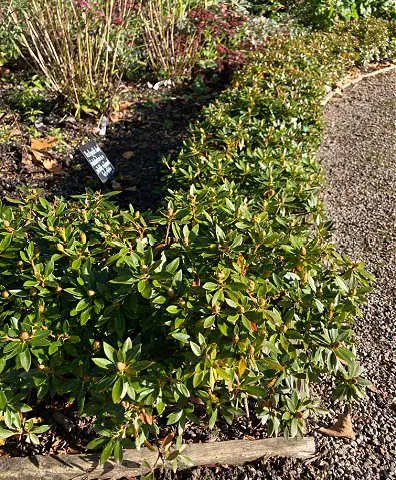
Left unchecked this miniature rhododendron will grow to 100cm high and spread, but it is ideal for pruning each year to keep as a low growing, evergreen groundcover plant. I spotted this at Aberglasney Gardens in Carmarthenshire, where they are using it as an alternative to Box hedging. In late spring or early summer, it produces plenty of pale pink flowers which look great against the fresh green new growth.
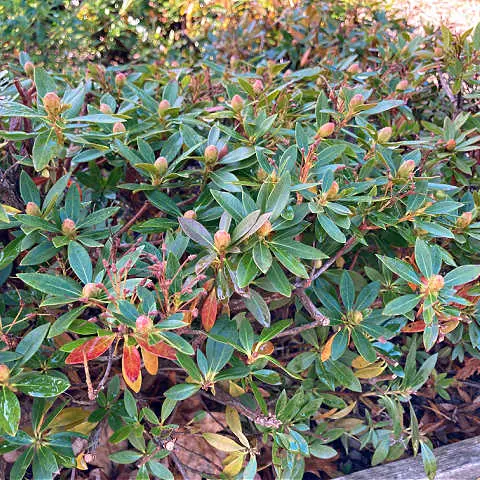
Grow in full sun or partial shade and on most soils except chalk. It needs acid or neutral soil and sheltered position. Avoid planting on a north-facing site. Prune immediately after flowering, so that you don’t remove next year’s flower buds. It is hardy across most of the UK, even in severe winters.
Bergenia purpurascens var. delavayi
For many years, I didn’t like what we called elephants’ ears plants, although I must have been in the minority as they seemed to be in every suburban garden in the area I lived. More recently, I have started to rather like them, having seen them providing groundcover in shrubberies and on the edges of woodland gardens.

In theory, this plant is a little fussier than many other groundcover plants, but I have seen it growing quite well in lots of situations. The thick, rubbery leaves are dark green to bronzy-purple, and although they have a slightly erect habit to 40cm height, will form a ground covering clump up to 5ocm spread or more. The colour becomes more intense during the cold weather of winter and where there are good light levels. Clusters of white or pink flowers appear on erect stems in spring. Grow in full sun or partial shaded. They prefer loamy, moist, but well-drained soil. They may fail to thrive in clay and chalk soils. You could also try Bergenia cordifolia Eroica.
Campanula portenschlagiana
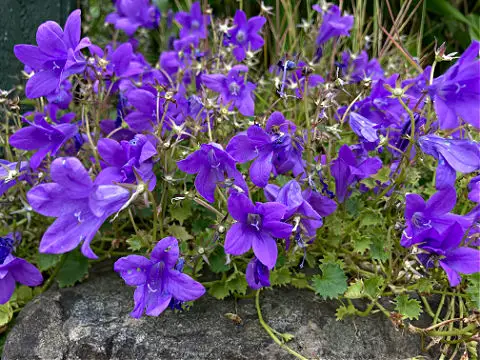
This Campanula quickly forms a dense mat of small evergreen foliage around 15cm height and in excess of 50cm. It grows well in walls, rockeries and gaps between paving stones as well as in borders. It will fail to thrive in heavy and clay soils or in full shade, but otherwise is unfussy about situation, position or aspect. During the summer Campanula portenschlagiana freely produces purple bell-shaped flowers. I saw one growing on top of a neighbour’s wall and asked for a few cuttings. Take basal cuttings for reliable propagation. It also grows readily from seed and may seed freely around the garden. Remove and dispose of unwanted plants, or better still, pot them and share with friends or at a plant swap.
Epimedium ‘Sphinx Twinkler’
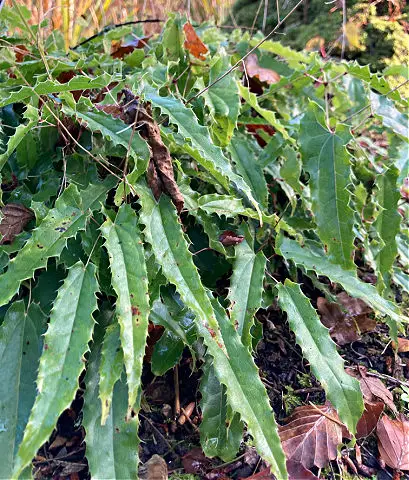
I was excited to spot this variety recently because, unlike most Epimedium, the leaves of ‘Sphinx Twinkler’ are elongated with spiky edges. The leaves of these plants drape elegantly to form a spreading clump of evergreen groundcover. The new leaves have a bronze-red tinge and the yellow and white flowers appear in spring. Height 25cm and spread 75cm. It grows well in full shade and partial shade and in most soils. It is hardy in most areas of UK, but in a severe winter or very dry period it may lose some of it leaves, making it a semi-evergreen option.
Gaultheria procumbens
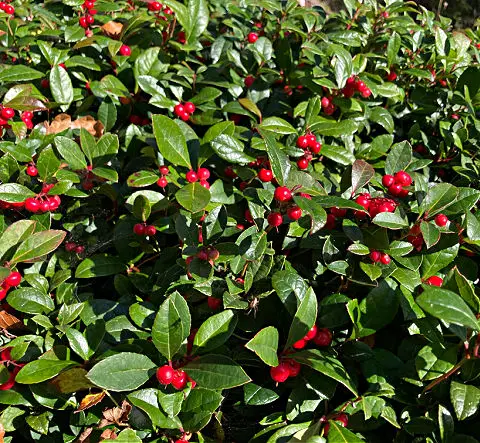
This is one of those plants that you may not notice for much of the year, but in autumn you can hardly miss it! Small, pink or white flowers that appeared in summer are followed by bright, non-edible berries in late summer and autumn. The leaves may have a red tint during winter, adding to the attractive qualities of this low growing evergreen shrub. Height 15cm, spreading slowly, but indefinitely. The leaves are aromatic when crushed, but this plant is non-edible. Gaultheria procumens grows well in full and partial shade on any aspect. It prefers moist, but well-drained soil that is acid or neutral, so avoid growing in chalky soil. It is hardy across the UK.
Stachys byzantina ‘Silver Carpet’
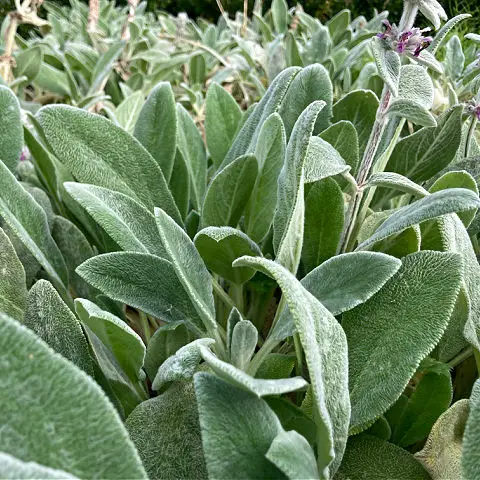
Lamb’s ears are well-known for their soft and downy, silver foliage, making them great in a sensory garden or, if like me, you like to touch leaves as you walk around your garden. Stachys byzantina is likely to fail to thrive on heavy and clay soils. However, if you can provide a south or west-facing position, in full sun and well-drained soil, it will reward you with a spreading carpet of thick, lush growth. Flowers in pink or purple appear in summer, they grow in whorls at intervals around the flower stem. It grows to 50cm height and 100cm spread. It is fully hardy in the UK and across most of Europe.
Lamium maculatum ‘Pink Pewter’
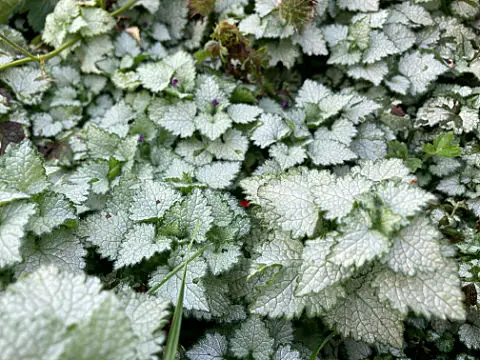
I’ve always thought that dead nettles were rather dull and uninteresting plants, but last year I had my mind changed when I saw how attractive the variegated varieties can be. Dead nettles can be evergreen or semi-evergreen depending on variety. I planted Lamium maculatum ‘Pink Pewter’ in our garden in the summer of 2023 and it came through last winter quite happily.
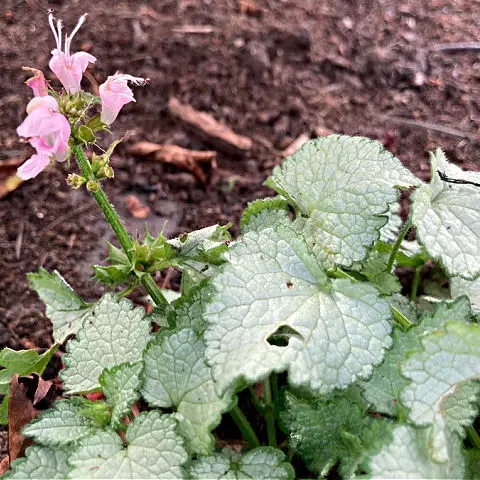
This low-growing plant spreads to around 45cms and produced attractive pale pink flowers during the summer months. Its silver leaves are edged with green, which means it brightens a dull corner and lifts the look of the surrounding plants.
Thyme
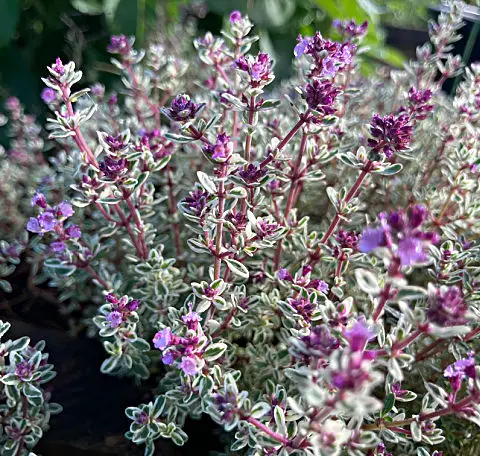
Thyme can be a useful evergreen ground cover, smothering weeds, giving a good flower display in summer that is loved by bees and other pollinators, and providing a useful herb for the kitchen.
Thrifty tip
Many groundcover plants will produce roots on their stems where they touch the ground. Take advantage of this natural layering process to create new plants. Find small sections that have rooted and carefully lift from the soil and detach from the parent plant. Transfer into pots to grow on or plant elsewhere in your garden.
More information
The article ‘Evergreen Groundcover’ was written for Amateur Gardening magazine in autumn 2024. I have updated some of the specific varieties and images. Links are included to help you find the suggested plants that have flowers producing a scent in the spring months.
If you know of other plants that are great as evergreen groundcover, please leave a comment, especially if you live in a climate that is different to the oceanic temperature climate of the UK. It would be great to build a resource for gardeners across the globe.
- Ball Shaped Flowers - October 24, 2025
- 10 Shrubs for Summer Colour - October 10, 2025
- Contrasting flower colours - September 26, 2025
